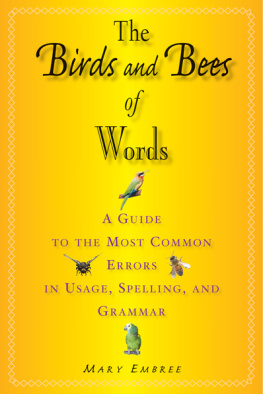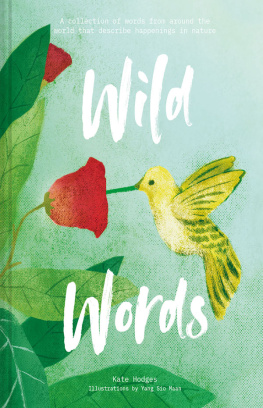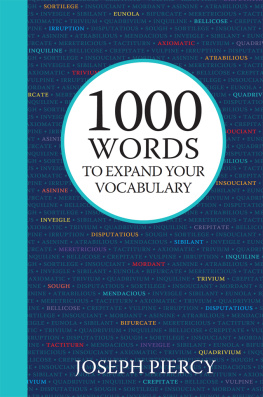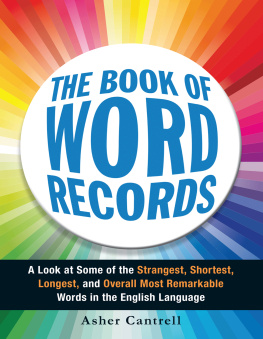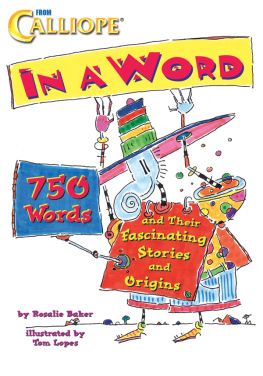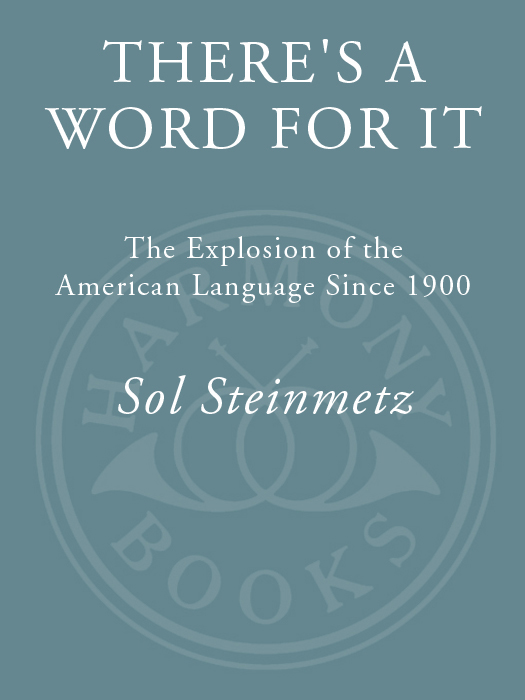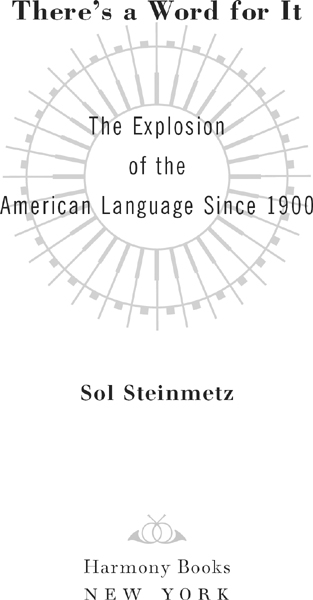ALSO BY SOL STEINMETZ
Semantic Antics: How and Why Words Change Meaning
The Life of Language: The Fascinating Ways Words Are Born, Live & Die
Dictionary of Jewish Usage: A Guide to the Use of Jewish Terms
The Story of Yiddish in America
Meshuggenary: Celebrating the World of Yiddish
Youthopia USA
To Tzippie, with love
Contents
Chapter 1 The Dawn of the Twentieth Century:
19001909
Chapter 2 The Ballroom Decade and the Great War:
19101919
Chapter 3
Chapter 4
Chapter 5
Chapter 6 MidcenturyThe Affluent Fifties:
19501959
Chapter 7
Chapter 8
Chapter 9
Chapter 10
Chapter 11
Introduction
Why This Book
T he idea for this book developed in the late 1990s, as I was writing the essay Defining Our Language for the 21st Century for the 1997 Edition of the Random House Websters College Dictionary. In that essay I tried to show how every decade since the 1940s has left its stamp on the English language. I surveyed the new vocabulary of each decade and listed a selection of words that reflected the decades peculiar character. For example, under the heading New Words of the 1940s I listed a group of terms beginning with A-bomb and ending with zip gun and zonk.
After writing the essay, I continued to collect new vocabulary to keep up with the expansion of English. As I wrote in the essay, Judging by its present rate of expansion, the English vocabulary is likely to continue its vigorous growth during the next century. The world-wide influence of English, reinforced by electronic communication, will develop further what has been already called World English, an international language whose ever-growing vocabulary derives from a rich mixture of native stock and foreign borrowings.
Since 1900 every decade has contributed a substantial number of new words to the English vocabulary. If we tackle each decade, we may discover a pattern that reflects the character and historical nature of the decade.
A Typical Decade: 192029
Almost five thousand new words were absorbed into English between 1920 and 1929. Among them were such terms as Dada and Dadaism, Fascism and Fascist, hijack (v.), id, leotard, mastectomy, motel, nonviolence, penicillin, scofflaw, superego, totalitarian and totalitarianism, and zipper. The list evokes a sense of the cultural, social, and political atmosphere of that decade.
Dada and Dadaism came into English from French in 1920 to challenge the conventional art world; Fascism and Fascist came from Italian in 1921 as precursors of the Nazi era; hijack surfaced in 1923 from the language of rumrunners during Prohibition; the id was a Freudian term that entered the language in 1924 along with ego and superego; leotard came in 1920 from the name of a French trapeze artist who wore the skintight garment; mastectomy was first recorded in 1923 in Stedmans Medical Dictionary; motel was coined in 1925 from motor hotel by a company that planned to build a chain of such roadside inns; nonviolence appeared in 1920 and was attributed to the Hindu nationalist leader Gandhi; penicillin was coined by its discoverer, Alexander Fleming, in 1929; scofflaw was a winning word in a 1924 contest to describe a person who breaks the law by drinking liquor illegally (remember, this was Prohibition); totalitarian and totalitarianism came in 1926 from Italian in reference to Fascism; and zipper, a new invention, was trademarked in 1925.
Of course, many new words of the 1920s are specifically linked to that decade: words like Babbit (a typical materialistic middle-class American of the time), bootleg (illicit liquor), Charleston (a popular dance of the era), flapper (a typically unconventional and frivolous young woman), Lindy hop (a dance named after the popular aviator Charles Lindbergh), ritzy (swanky, elegant, like the Ritz hotels), and the Lost Generation (the expatriate intellectuals of postWorld War I). But even these words were not fly-by-night, but terms of genuine historical interest that are still in use.
What Dictionaries Show Us
The English language has today a larger vocabulary than most languages of the world. A comparison of the contents of English monolingual dictionaries since the 1700s suggests the extent of the expansion. One of the earliest modern English dictionaries, Samuel Johnsons Dictionary of the English Language (1755), contained about 50,000 entries. The next dictionary classic, Noah Websters American Dictionary of the English Language (1828), included about 75,000 entries. The numbers kept increasing throughout the 1800s as dictionary makers strove to excel in their coverage of the English lexicon. The broadest coverage of English words occurred in the twentieth century. Websters Third New International Dictionary, which appeared to great fanfare (and controversy) in 1961, claimed 450,000 entries. Almost fifty years later, the great Oxford English Dictionary lists approximately 616,500 word forms (free forms, combining forms, compounds, derivatives, phrases, etc.).
How Many Words Are in English?
There is little doubt that the English vocabulary has expanded greatly over the centuries. Compare the number of new words recorded in the five centuries between 1400 and 1900:
| 14001499: | 1,025 words |
| 15001599: | 36,553 words |
| 16001699: | 48,232 words |
| 17001899: | 93,205 words |
The difference in numbers between the 1400s and the 1800s is striking. One obvious reason for the huge discrepancy is that by the nineteenth century, more words were being collected by dictionary editors, like James Murray (18371915) of the Oxford English Dictionary, than ever before. Nevertheless, the size of the actual expansion is much in question. The lexicographer Sidney I. Landau, in Dictionaries: The Art and Craft of Lexicography (1984), presented the problem squarely: How large is the English lexicon? Allen Walker Read [in Current Trends in Linguistics, vol. 10, 1972] estimates its extent at about four million. He adduces this figure by citing 700,000 words in the Merriam-Webster files [only a fraction of which make it into the dictionary] and at least one million words in the scientific vocabulary.
Landau goes on to disavow on many grounds Reads estimate. The question, How many words are in the English language? he writes, cannot be answered in any satisfactory way. It depends on what one means by words and by English, and even if one could decide the limits to each, the answer would be little more than a guess. Or, as Philip B. Gove, the editor of Websters Third, puts it in his preface, This dictionary has a vocabulary of over 450,000 words. By itself, the number of entries is, however, not of first importance. The number of words available is always far in excess of the number that can possibly be included.



